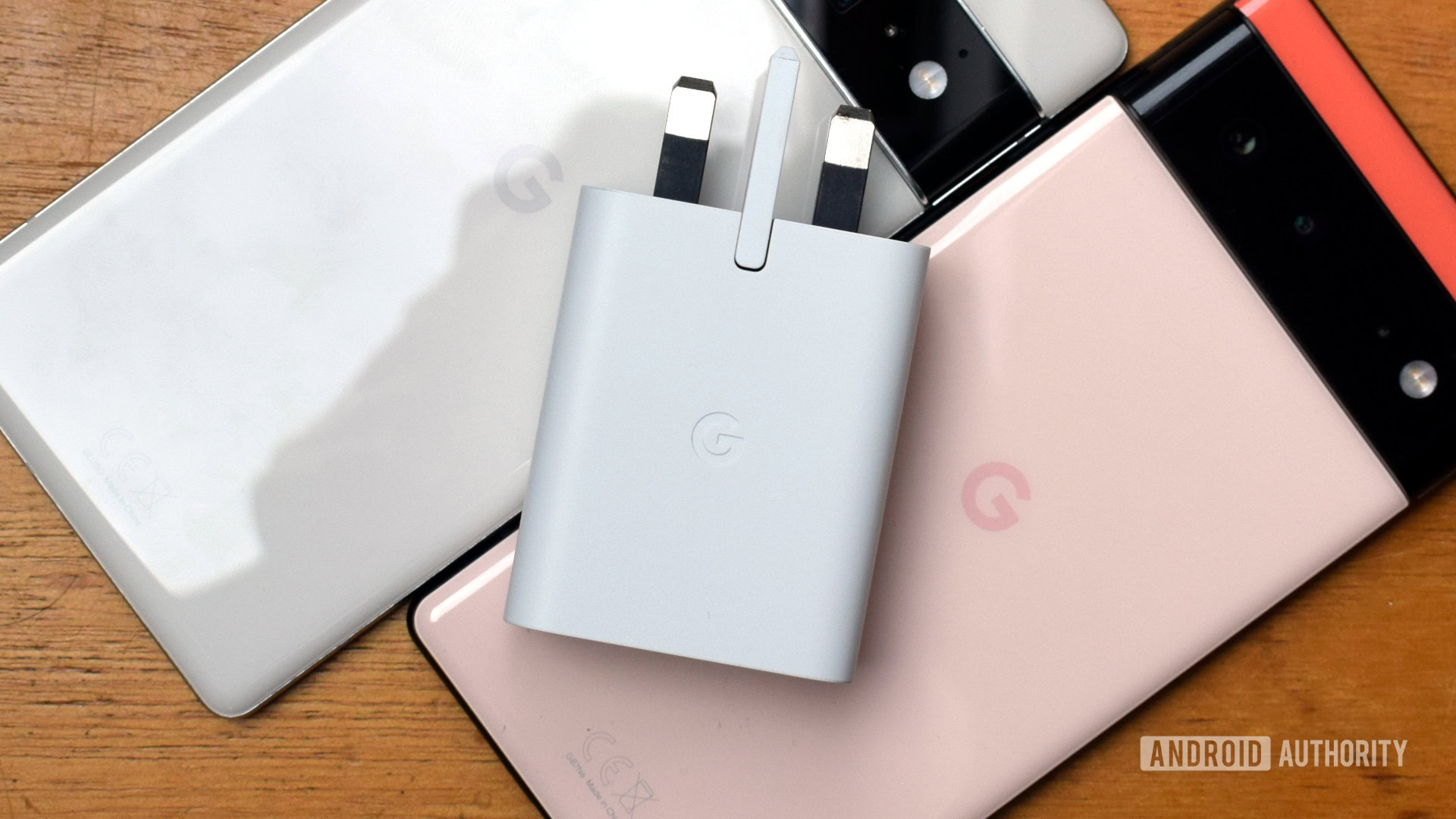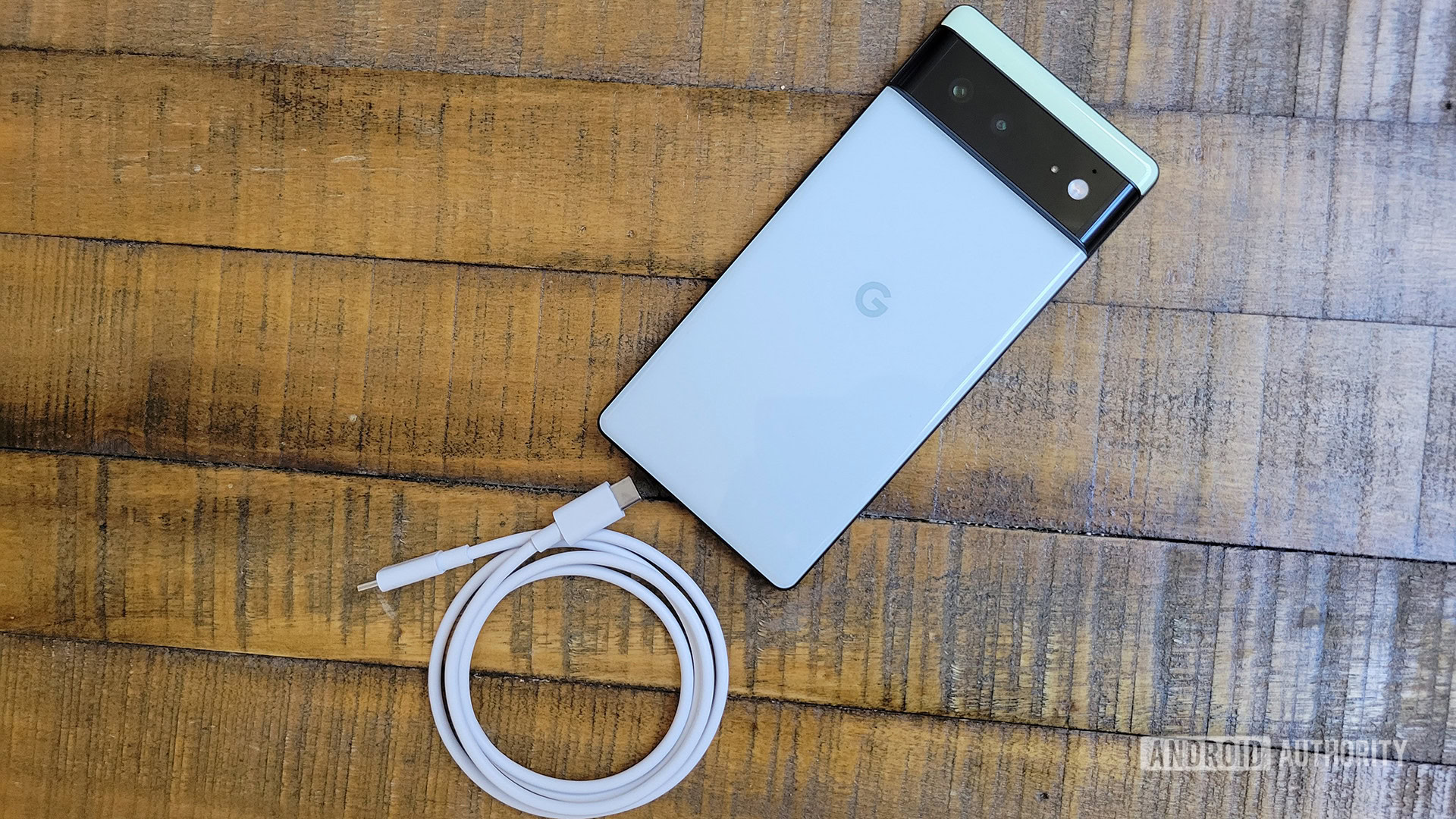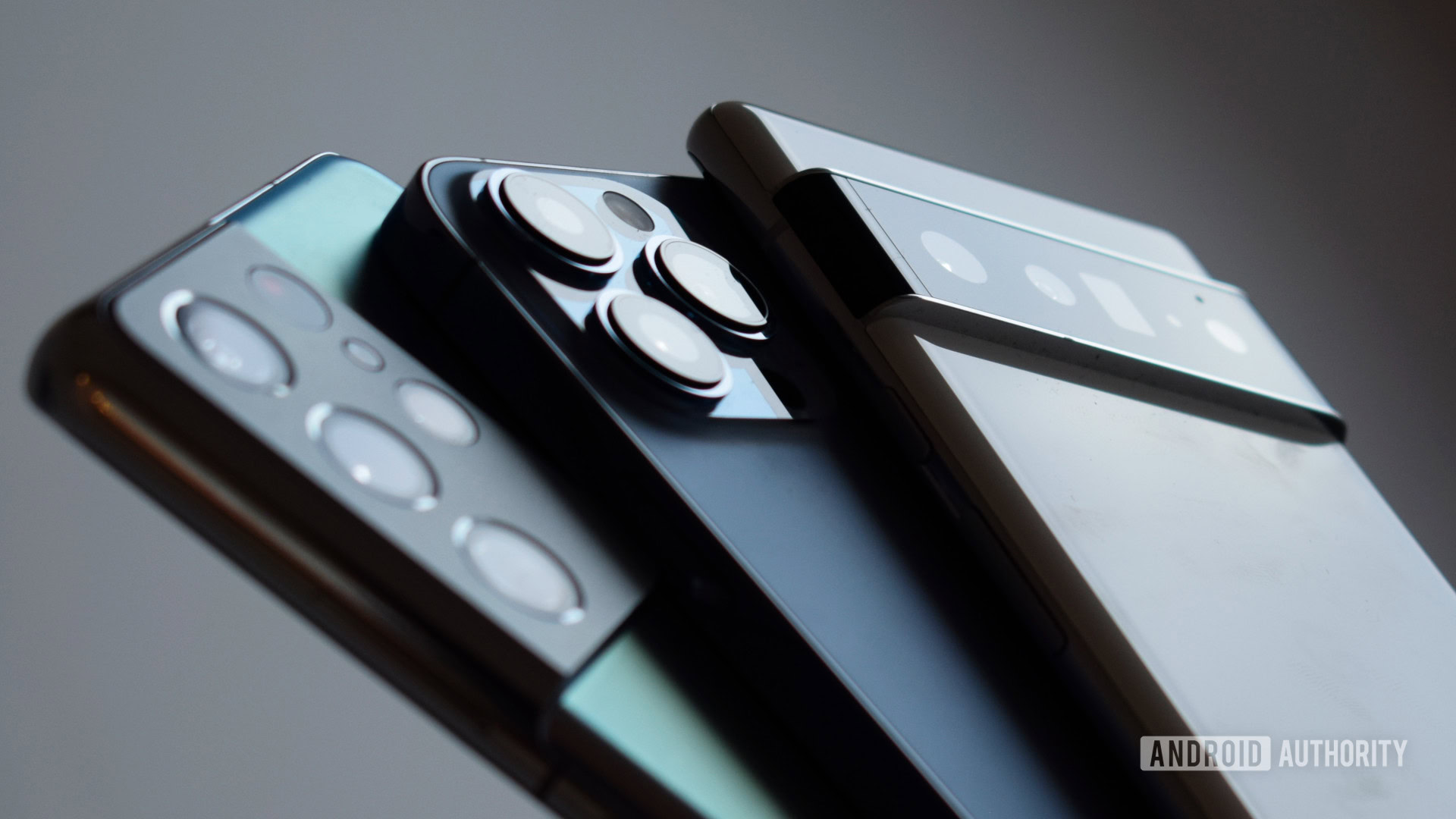Affiliate links on Android Authority may earn us a commission. Learn more.
Tested: The Pixel 6 charges much slower than Google implied

You’d be forgiven for thinking that the Google Pixel 6 and Pixel 6 Pro had finally boarded the fast charging express. Google’s adoption of the USB Power Delivery PPS charging protocol and recommendation that you use its latest 30W USB-C adapter to obtain peak speeds certainly suggests as much. But one should never jump to assumptions and it turns out Google’s 2021 phones don’t break any records for charging times.
Anyone who has used the phone will no doubt grimace at the “two hours to full” message received upon plugging in. Despite Google’s boasts of a 50% charge in 30 minutes, a full-cycle takes an inexplicable amount of time. Looking more closely at the literature, Google doesn’t actually state the peak wired charging speed for the Pixel 6 or Pixel 6 Pro. Here’s what the official Google Pixel 6 support page says:
Up to 50% charge in 30 minutes with Google 30W USB-C. Charger with USB-PD 3.0 (PPS) sold separately.Fast wired charging rates are based upon use of the Google 30W USB-C Charger plugged into a wall outlet. Compatible with USB PD 3.0 PPS adapters. Actual results may be slower. Adapters sold separately.
Confused? Fortunately, Android Authority has been in the lab to take a closer look at what’s causing these long charge times. The verdict? The assumed 30W charging isn’t 30W at all.
October 2023: Google has improved charging speeds with the Pixel 8 series. We recorded a measurable reduction in zero-to-full times, which you can find in our Pixel 8 charging test article.
October 2022: The Pixel 7 series exhibited similar charging behavior as described in this article. We've published our findings in a dedicated Pixel 7 charging test.
Google issued a statement on the Pixel 6 series' charging capabilities following the original publication of this article. You can find more details below. The remainder of the article has been preserved as published in late 2021.
Google Pixel 6 wired charging tested

Based on our testing using Google’s official 30W USB-C Adapter and a handful of compatible fast charging cables, we discovered that the maximum power obtained from both the Pixel 6 and Pixel 6 Pro is just 22W, with an average of just 13W over a full cycle. At no point during our testing did we see speeds anywhere close to the 30W charging that many have (quite fairly) assumed the Pixel 6 series is capable of.
We corroborated these findings with tests using other high-power USB Power Delivery PPS plugs such as the Anker Nano II, Samsung 45W Travel Adapter, and the Elecjet X21 Pro — all of which showed a maximum output of 22W when charging either the Pixel 6 or Pixel 6 Pro. All of the adapters used were UK variants, though our data from testing US chargers with USB PD PPS support also showed peak charging of 22W or below on a US model Pixel 6.
Google Pixel 6 charging power tops out at 22W, not 30W.
How does that impact charging times? With USB Power Delivery PPS, the Google Pixel 6 Pro takes ~111 minutes to fully charge its 5,000mAh battery (~5,000mAh typical, according to Google) from near empty. This figure, as well as all the data shown in this article, was obtained with the Pixel 6 series’ Adaptive Charging and Adaptive Battery settings switched off. All charging times noted here are based on our average numbers across multiple tests.
Given that the 4,080mAh capacity Pixel 5 supports 18W charging and fills up in around 87 minutes, that’s pretty disappointing. Furthermore, 22W isn’t far shy of the 5,000mAh Samsung Galaxy S21 Ultra’s 25W charging capabilities, which can be filled up in a little over an hour with the right charger. So why the huge discrepancy?
To find out, we have to look closer at how charging power changes over the course of a cycle. Typically, fast charging uses more power at the beginning of the charge, during a battery’s constant current phase, before reducing power as the cell nears full capacity. Reducing power earlier is useful for controlling temperatures and reducing battery stress but comes at the cost of charge time.
The graph below tracks the amount of charging power used by the Pixel 6 Pro as a measure of time and battery capacity.
As mentioned, the Pixel 6 Pro tops out at 22W of power, far below the maximum charging potential offered by the adapter itself (as we’ll see in the next section). This peak power draw is sustained until 50% charge, which takes about 31 minutes, virtually as advertised.
However, after that initial period of fast charging, power sent to the phone falls to 15W at around 62% battery capacity or around 40 minutes. This remains steady until falling further to just 12W by 75% capacity, which takes around 53 minutes to hit. From there the power holds steady once more until 85% charge is obtained at around the 63-minute mark. After that point, power gradually falls to as little as 2.5W by the time the battery is full.
Charging this last 15% of the battery takes an exorbitant about of time, requiring a further hour to finish filling up. Oddly, the phone actually switches back to the standard USB Power Delivery protocol after hitting around 75% battery capacity. There’s no clear reason for this and might be a hangover from Google’s old charging algorithm, as we’ll see later.
After hitting 50% charge, power falls from 22W to 15W and then well below.
Looking at a full charge cycle, the phone is reasonably quick to hit 50% but the following 50% takes three times as long.
Temperature-wise, the phone didn’t break 35°C peak, which is very good, though it’s quickly turning to winter at the time of writing, so the external temperature may have played a small factor. Still, there’s plenty of thermal headroom in the latter stages of charging, with battery temperatures hovering close to just 25°C. The only other reason for Google to be playing it so conservatively is so as not to strain a reasonably cheap low C-Rate battery.
Google Pixel 6 Pro vs Samsung Galaxy S21 Ultra fast charging test

To get a taste of whether the Pixel 6 and 6 Pro’s behavior is unusual, we also tested the previous generation Google Pixel 5 and the Samsung Galaxy S21 Ultra using the same official 30W Google charger.
The Galaxy S21 Ultra also uses the USB Power Delivery PPS protocol to negotiate up to 25W of power and houses a 5,000mAh battery, making it an excellent reference for the Pixel 6 Pro. The Pixel 5 also gives us some useful data, as it shows how Google charged its previous phones using the USB Power Delivery 2.0 specification.
Immediately we see the Galaxy S21 Ultra pulling more power than the Pixel 6 Pro from Google’s own adapter. It draws 25W from the same plug and even hits peaks of 28W before reducing its charging power at the 50% mark. Even after this mark, the power draw falls to a still speedy 20W before tailing off down towards 6W for the last 15% of the phone’s charge. The phone also uses the USB PD PPS standard for the entire charge cycle. The net result is a much faster 62 minutes to full charge, 49 minutes faster than the Pixel 6 Pro for the same battery capacity.
The Galaxy S21 Ultra pulls more power than the Pixel 6 Pro from Google's own adapter, charging ~49 minutes faster than the Pixel 6 Pro, despite the same battery capacity.
There is a minor trade-off here though. The Galaxy S21 Ultra’s battery temperature hovers around 35°C for the fast-charge portion and above 30°C for the remaining charge cycle. Still, this is reasonably cool compared to the 60W+ fast-charging standards we see on the market.
Comparing the Google Pixel 6 Pro to the Pixel 5 shows that the company is using a virtually identical charging algorithm for both phones, just with fractionally more power used by the newer model. The handsets follow an almost identical step-down approach to lowering power as the phone’s battery fills up. While stepping off the gas is necessary as a battery fills up, Google’s approach is clearly far more conservative than Samsung’s implementation of USB PD PPS or Super Fast Charging.
Do you need to buy Google’s 30W PPS charger?

The benefit of USB PD PPS over the regular USB PD standard is that it allows for more fine-grain control of current and voltage delivery when combined with improved device-to-charger communication. In other words, Google should be able to charge the phone faster and more efficiently with the move to PPS, optimizing the power delivered based on battery condition, temperature, and more.
While Google has leveraged the standard for marginally higher power, there’s no sign of PPS being used to better optimize the Pixel 6 Pro’s charging speed any more dynamically than previous Pixels. I can’t understand why Google would move over to an entirely new charging standard, thereby breaking accessory compatibility, just to supply 4W more power to the Pixel 6.
Google's new 30W charger saves you just 10 minutes over the old 18W model. Hardly worth the money.
As a final test, I charged the Google Pixel 6 Pro using Google’s old 18W USB Power Delivery plug the company shipped with previous generation Pixels. Just to see if there’s any tangible benefit. The results are somewhat galling.
| 25% Charge | 50% Charge | 75% Charge | 100% Charge | |
|---|---|---|---|---|
Google Pixel 6 Pro USB PD PPS 30W | 25% Charge 15 minutes | 50% Charge 31 minutes | 75% Charge 53 minutes | 100% Charge 111 minutes |
Google Pixel 6 Pro USB PD 18W | 25% Charge 19 minutes | 50% Charge 40 minutes | 75% Charge 64 minutes | 100% Charge 121 minutes |
When using USB Power Delivery, the Pixel 6 and Pixel 6 Pro charge at 18W until around 60% battery when power falls to 15W — just like when charging with USB PD PPS. The result is the phone hits 50% charge in 40 minutes rather than 31 minutes, and a full Pixel 6 Pro charge takes 121 versus 111 minutes. Hardly a game-changing time saver by moving from an 18W to 30W plug.
Although a PPS charger will have you back on your feet to 50% a little quicker, it’s certainly not worth spending an extra $25 on Google’s 30W USB-C adapter just to charge the phone 10 minutes faster. While it’s a perfectly good charger in its own right (as seen with the Galaxy S21 Ultra results), any 18W USB Power Delivery plug left over from an older handset will serve you virtually as well as Google’s new adapter.
Google Pixel 6 charging: Why it matters

It’s hard not to be disappointed by the fast charging capabilities of the Google Pixel 6 and Pixel 6 Pro. Especially given Google’s tacit suggestion that its new phones charge faster than ever before thanks to the new 30W power adapter. While not an outright lie, Google’s literature is certainly disingenuous about the phones’ capabilities.
The carefully worded official line cited in this article’s opening paragraph has, intentionally or not, duped customers and the press (ourselves included) into believing the Pixel 6 series supports much more powerful charging than it actually does. In reality, Google’s latest flagships offer only marginal improvements to charging speeds, saving mere minutes of time compared to the company’s previous implementation.
Google's latest flagships offer only marginal improvements to charging speeds.
The bottom line — Google hasn’t leapfrogged Apple and Samsung as it seemingly tried to imply. In fact, the Pixel 6 and 6 Pro charge slower than their two biggest competitors. Considering those two already lag behind the slew of brands offering much speedier, market-leading fast charging technologies, Google finds itself in a less-than-stellar position in the pantheon of fast charging phones. With the latest Pixel devices providing exclusive features and hardware upgrades over previous Pixels, it’s a shame its charging hasn’t caught up.
A few weeks after we originally published our findings, Google clarified the charging capabilities of the Pixel 6 and Pixel 6 Pro. The community blog post confirmed our findings that the Pixel 6 and 6 Pro draw 21W and 23W at their peaks respectively, before reducing power as the battery capacity fills. That’s within a 1W margin of error from our testing, which is likely down to variables such as the cable used, ambient temperature, their use of pre-production software, and whether the measurement was taken at the phone or the plug.